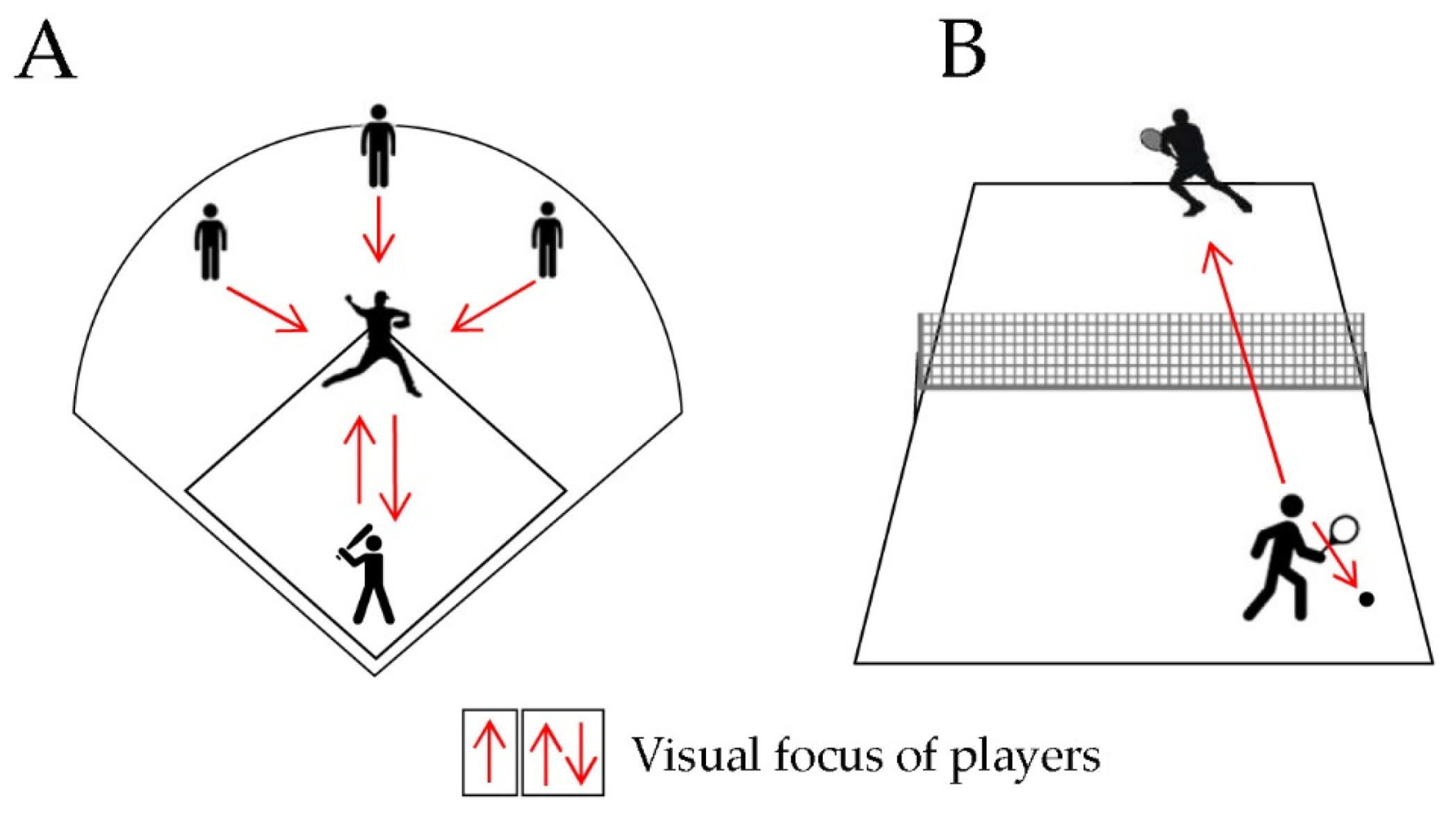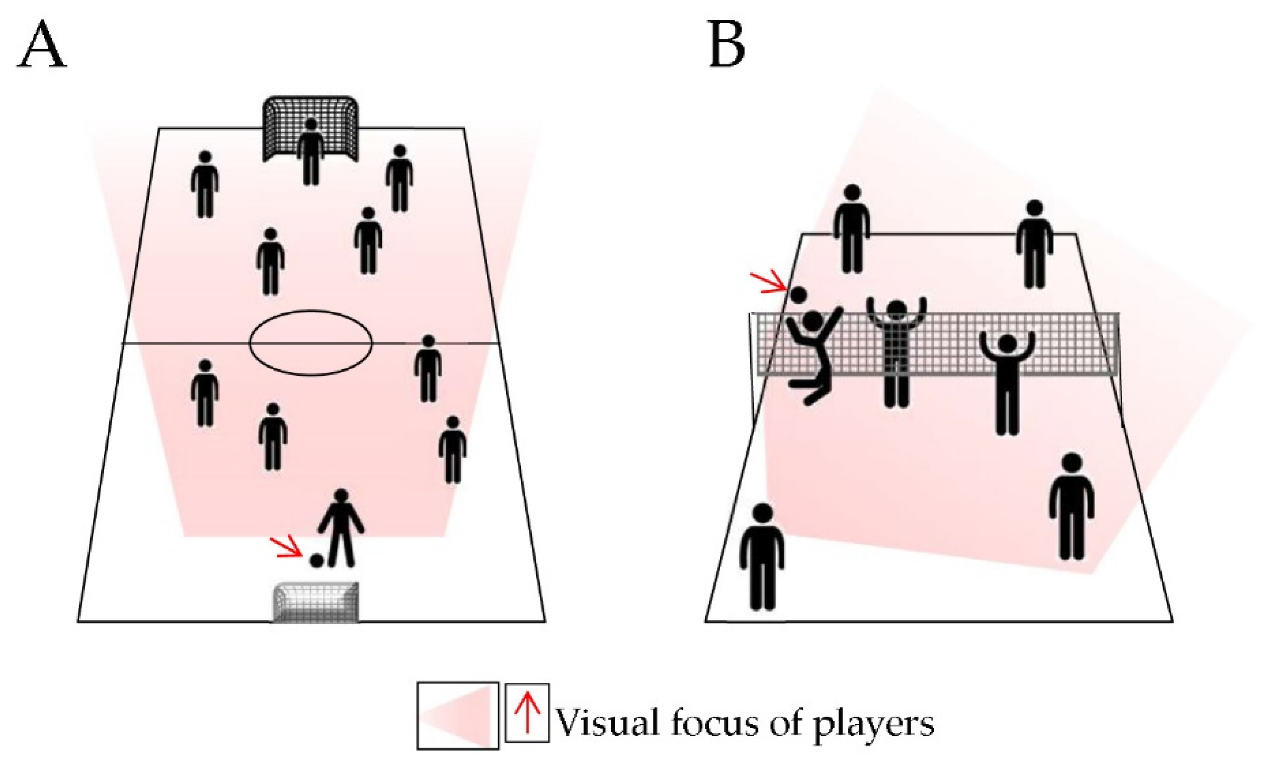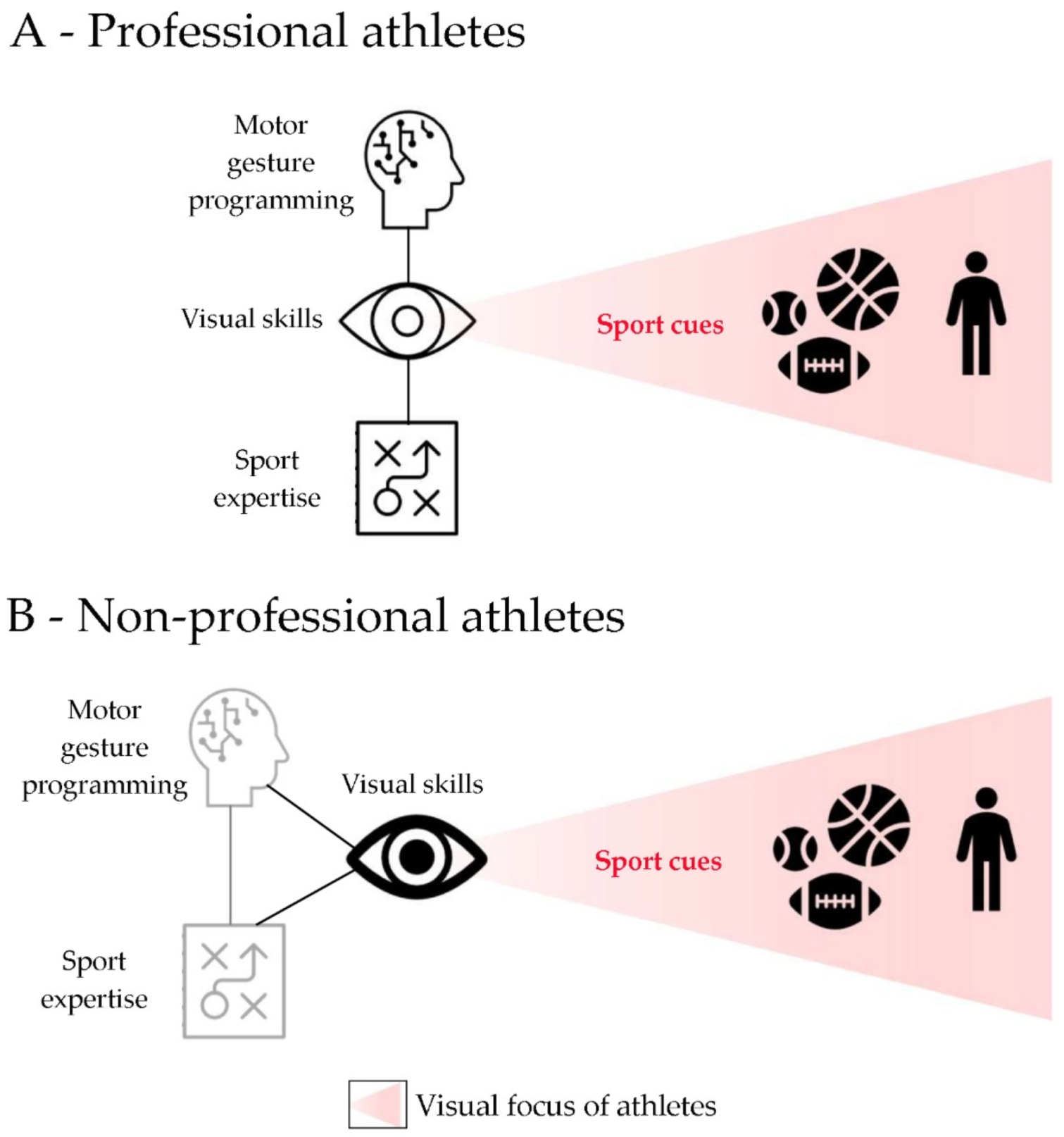Stereopsis in Sports: Visual Skills and Visuomotor Integration Models in Professional and Non-Professional Athletes
Abstract
1. Introduction
2. Stereopsis and Sports
2.1. Interceptive Sports
Stereopsis in Putting and Shooting Actions
2.2. Strategic Sports
3. Vision Training
4. A Proposed Model of Visuomotor Integration
5. Summary and Conclusions
Author Contributions
Funding
Institutional Review Board Statement
Informed Consent Statement
Data Availability Statement
Conflicts of Interest
References
- Stine, C.D.; Arterburn, M.R.; Stern, N.S. Vision and sports: A review of the literature. J. Am. Optom. Assoc. 1982, 53, 627–633. [Google Scholar] [PubMed]
- Hitzeman, S.; Beckerman, S. What the literature says about sports vision. Optom. Clin. Off. Publ. Prentice Soc. 1993, 3, 145–169. [Google Scholar]
- Regan, D.; Gray, R. Hitting what one wants to hit and missing what one wants to miss. Vis. Res. 2001, 41, 3321–3329. [Google Scholar] [CrossRef]
- Sharma, P. The pursuit of stereopsis. J. Am. Assoc. Pediatr. Ophthalmol. Strabismus 2018, 22, 2.e1–2.e5. [Google Scholar] [CrossRef]
- Newell, A. Unified Theories of Cognition; Harvard University Press: Cambridge, MA, USA, 1994. [Google Scholar]
- McBeath, M.K.; Tang, T.Y.; Shaffer, D.M. The geometry of consciousness. Conscious. Cogn. 2018, 64, 207–215. [Google Scholar] [CrossRef] [PubMed]
- Lenoir, M.; Musch, E.; La Grange, N. Ecological Relevance of Stereopsis in One-Handed Ball-Catching. Percept. Mot. Ski. 1999, 89, 495–508. [Google Scholar] [CrossRef]
- Mazyn, L.I.N.; Lenoir, M.; Montagne, G.; Savelsbergh, G.J.P. The contribution of stereo vision to one-handed catching. Exp. Brain Res. 2004, 157, 383–390. [Google Scholar] [CrossRef]
- Mazyn, L.I.N.; Lenoir, M.; Montagne, G.; Delaey, C.; Savelsbergh, G.J.P. Stereo vision enhances the learning of a catching skill. Exp. Brain Res. 2007, 179, 723–726. [Google Scholar] [CrossRef]
- Burris, K.; Liu, S.; Appelbaum, L. Visual-motor expertise in athletes: Insights from semiparametric modelling of 2317 athletes tested on the Nike SPARQ Sensory Station. J. Sports Sci. 2020, 38, 320–329. [Google Scholar] [CrossRef]
- Boden, L.M.; Rosengren, K.J.; Martin, D.F.; Boden, S.D. A comparison of static near stereo acuity in youth baseball/softball players and non–ball players. Optom.—J. Am. Optom. Assoc. 2009, 80, 121–125. [Google Scholar] [CrossRef] [PubMed]
- Quintana, M.S.; Román, I.R.; Calvo, A.L.; Molinuevo, J.S. Perceptual Visual Skills in Young Highly Skilled Basketball Players. Percept. Mot. Ski. 2007, 104, 547–561. [Google Scholar] [CrossRef] [PubMed]
- O’Connor, A.R.; Tidbury, L.P. Stereopsis: Are we assessing it in enough depth? Clin. Exp. Optom. 2018, 101, 485–494. [Google Scholar] [CrossRef]
- O’Connor, A.R.; Birch, E.E.; Anderson, S.; Draper, H.; FSOS Research Group. The Functional Significance of Stereopsis. Investig. Opthalmol. Vis. Sci. 2010, 51, 2019–2023. [Google Scholar] [CrossRef] [PubMed]
- Gao, Y.; Chen, L.; Yang, S.-N.; Wang, H.; Yao, J.; Dai, Q.; Chang, S. Contributions of Visuo-oculomotor Abilities to Interceptive Skills in Sports. Optom. Vis. Sci. 2015, 92, 679–689. [Google Scholar] [CrossRef] [PubMed]
- Regan, D. Vision and cricket. Ophthalmic Physiol. Opt. 2012, 32, 257–270. [Google Scholar] [CrossRef]
- Regan, D. Visual factors in hitting and catching. J. Sports Sci. 1997, 15, 533–558. [Google Scholar] [CrossRef] [PubMed]
- Müller, S.; Lalovic, A.; Dempsey, A.; Rosalie, S.; Harbaugh, A.G. Pick-up of Early Visual Information to Guide Kinetics and Kinematics within a Group of Highly Skilled Baseball Batters. Percept. Mot. Ski. 2014, 119, 347–362. [Google Scholar] [CrossRef]
- Hülsdünker, T.; Strüder, H.K.; Mierau, A. The athletes’ visuomotor system—Cortical processes contributing to faster visuomotor reactions. Eur. J. Sport Sci. 2018, 18, 955–964. [Google Scholar] [CrossRef]
- Laby, D.M.; Kirschen, D.G.; Govindarajulu, U.; Deland, P. The Effect of Visual Function on the Batting Performance of Professional Baseball Players. Sci. Rep. 2019, 9, 16847. [Google Scholar] [CrossRef]
- Hülsdünker, T.; Strüder, H.K.; Mierau, A. Visual Motion Processing Subserves Faster Visuomotor Reaction in Badminton Players. Med. Sci. Sports Exerc. 2017, 49, 1097–1110. [Google Scholar] [CrossRef]
- Tanaka, H.; Iwami, M. Estimating Putting Outcomes in Golf: Experts Have a Better Sense of Distance. Percept. Mot. Ski. 2018, 125, 313–328. [Google Scholar] [CrossRef] [PubMed]
- Shim, J.; Chung, H.; Kim, J. Directional aiming bias in golf putting. J. Sports Sci. 2019, 37, 364–369. [Google Scholar] [CrossRef] [PubMed]
- Van Lier, W.H.; van der Kamp, J.; Savelsbergh, G.J. Perception and Action in Golf Putting: Skill Differences Reflect Calibration. J. Sport Exerc. Psychol. 2011, 33, 349–369. [Google Scholar] [CrossRef]
- Micarelli, A.; Viziano, A.; Lanzillotta, A.; Ruscello, B.; D’Ottavio, S.; Alessandrini, M. Visual dependency and postural control on swing performance in golf players. Eur. J. Sport Sci. 2019, 19, 922–930. [Google Scholar] [CrossRef] [PubMed]
- Kim, Y.; Chang, T.; Park, I. Visual Scanning Behavior and Attention Strategies for Shooting among Expert Versus Collegiate Korean Archers. Percept. Mot. Ski. 2019, 126, 530–545. [Google Scholar] [CrossRef]
- Mohammadi, S.F.; Amiri, M.A.; Naderifar, H.; Rakhshi, E.; Vakilian, B.; Ashrafi, E.; Behesht-Nejad, A.-H. Vision Examination Protocol for Archery Athletes Along With an Introduction to Sports Vision. Asian J. Sports Med. 2016, 7, 26591. [Google Scholar] [CrossRef]
- Zhu, X.-J.; Li, Y.-H.; Liu, L.-Q. Functional significance of stereopsis in professional table-tennis players. J. Sports Med. Phys. Fit. 2019, 59, 1798–1804. [Google Scholar] [CrossRef]
- Natsuhara, T.; Kato, T.; Nakayama, M.; Yoshida, T.; Sasaki, R.; Matsutake, T.; Asai, T. Decision-Making While Passing and Visual Search Strategy During Ball Receiving in Team Sport Play. Percept. Mot. Ski. 2020, 127, 468–489. [Google Scholar] [CrossRef]
- Vera, J.; Jiménez, R.; Cárdenas, D.; Redondo, B.; García, J.A. Visual function, performance, and processing of basketball players vs. sedentary individuals. J. Sport Health Sci. 2020, 9, 587–594. [Google Scholar] [CrossRef]
- Jin, P.; Li, X.; Ma, B.; Guo, H.; Zhang, Z.; Mao, L. Dynamic visual attention characteristics and their relationship to match performance in skilled basketball players. PeerJ 2020, 8, e9803. [Google Scholar] [CrossRef]
- Stöckel, T.; Breslin, G. The influence of visual contextual information on the emergence of the especial skill in basketball. J. Sport Exerc. Psychol. 2013, 35, 536–541. [Google Scholar] [CrossRef] [PubMed]
- Czyż, S.; Kwon, O.-S.; Marzec, J.; Styrkowiec, P.; Breslin, G. Visual uncertainty influences the extent of an especial skill. Hum. Mov. Sci. 2015, 44, 143–149. [Google Scholar] [CrossRef] [PubMed]
- Williams, A.M.; Davids, K.; Burwitz, L.; Williams, J.G. Visual Search Strategies in Experienced and Inexperienced Soccer Players. Res. Q. Exerc. Sport 1994, 65, 127–135. [Google Scholar] [CrossRef] [PubMed]
- Ando, S.; Kida, N.; Oda, S. Central and Peripheral Visual Reaction Time of Soccer Players and Nonathletes. Percept. Mot. Ski. 2001, 92 Pt 1, 786–794. [Google Scholar] [CrossRef]
- Pesce, C.; Tessitore, A.; Casella, R.; Pirritano, M.; Capranica, L. Focusing of visual attention at rest and during physical exercise in soccer players. J. Sports Sci. 2007, 25, 1259–1270. [Google Scholar] [CrossRef] [PubMed]
- Basevitch, I.; Tenenbaum, G.; Land, W.M.; Ward, P. Visual and skill effects on soccer passing performance, kinematics, and outcome estimations. Front. Psychol. 2015, 6, 198. [Google Scholar] [CrossRef] [PubMed][Green Version]
- Paulus, J.; Tong, J.; Hornegger, J.; Schmidt, M.; Eskofier, B.; Michelson, G. Extended stereopsis evaluation of professional and amateur soccer players and subjects without soccer background. Front. Psychol. 2014, 5, 1186. [Google Scholar] [CrossRef][Green Version]
- Ghasemi, A.; Momeni, M.; Jafarzadehpur, E.; Rezaee, M.; Taheri, H. Visual Skills Involved in Decision Making by Expert Referees. Percept. Mot. Ski. 2011, 112, 161–171. [Google Scholar] [CrossRef]
- Piras, A.; Lobietti, R.; Squatrito, S. Response Time, Visual Search Strategy, and Anticipatory Skills in Volleyball Players. J. Ophthalmol. 2014, 2014, 189268. [Google Scholar] [CrossRef]
- Wimshurst, Z.L.; Sowden, P.T.; Cardinale, M. Visual Skills and Playing Positions of Olympic Field Hockey Players. Percept. Mot. Ski. 2012, 114, 204–216. [Google Scholar] [CrossRef]
- Rezaee, M.; Ghasemi, A.; Momeni, M. Visual and Athletic Skills Training Enhance Sport Performance. Eur. J. Exp. Biol. 2012, 2, 2243–2250. [Google Scholar]
- Zwierko, T.; Puchalska-Niedbal, L.; Krzepota, J.; Markiewicz, M.; Woźniak, J.; Lubiński, W. The Effects of Sports Vision Training on Binocular Vision Function in Female University Athletes. J. Hum. Kinet. 2015, 49, 287–296. [Google Scholar] [CrossRef]
- Zimmerman, A.; Lust, K.L.; Bullimore, M. Visual Acuity and Contrast Sensitivity Testing for Sports Vision. Eye Contact Lens Sci. Clin. Pract. 2011, 37, 153–159. [Google Scholar] [CrossRef] [PubMed]
- Laby, D.M.; Kirschen, D.G.; Pantall, P. The Visual Function of Olympic-Level Athletes—An Initial Report. Eye Contact Lens Sci. Clin. Pract. 2011, 37, 116–122. [Google Scholar] [CrossRef]
- Clark, J.F.; Colosimo, A.; Ellis, J.K.; Mangine, R.; Bixenmann, B.; Hasselfeld, K.; Graman, P.; Elgendy, H.; Myer, G.; Divine, J. Vision Training Methods for Sports Concussion Mitigation and Management. J. Vis. Exp. 2015, 99, e52648. [Google Scholar] [CrossRef]
- Schoemann, M.D.; Lochmann, M.; Paulus, J.; Michelson, G. Repetitive dynamic stereo test improved processing time in young athletes. Restor. Neurol. Neurosci. 2017, 35, 413–421. [Google Scholar] [CrossRef] [PubMed]
- Klemish, D.; Ramger, B.; Vittetoe, K.; Reiter, J.P.; Tokdar, S.T.; Appelbaum, L.G. Visual abilities distinguish pitchers from hitters in professional baseball. J. Sports Sci. 2018, 36, 171–179. [Google Scholar] [CrossRef] [PubMed]
- Poltavski, D.; Biberdorf, D. The role of visual perception measures used in sports vision programmes in predicting actual game performance in Division I collegiate hockey players. J. Sports Sci. 2015, 33, 597–608. [Google Scholar] [CrossRef]
- Burris, K.; Vittetoe, K.; Ramger, B.; Suresh, S.; Tokdar, S.T.; Reiter, J.P.; Appelbaum, L.G. Sensorimotor abilities predict on-field performance in professional baseball. Sci. Rep. 2018, 8, 116. [Google Scholar] [CrossRef]
- Ultimo, S.; Zauli, G.; Martelli, A.M.; Vitale, M.; McCubrey, J.A.; Capitani, S.; Neri, L.M. Influence of physical exercise on microRNAs in skeletal muscle regeneration, aging and diseases. Oncotarget 2018, 9, 17220–17237. [Google Scholar] [CrossRef]
- Simioni, C.; Zauli, G.; Martelli, A.M.; Vitale, M.; Sacchetti, G.; Gonelli, A.; Neri, L.M. Oxidative stress: Role of physical exercise and antioxidant nutraceuticals in adulthood and aging. Oncotarget 2018, 9, 17181–17198. [Google Scholar] [CrossRef] [PubMed]
- Masselli, E.; Pozzi, G.; Vaccarezza, M.; Mirandola, P.; Galli, D.; Vitale, M.; Carubbi, C.; Gobbi, G. ROS in Platelet Biology: Functional Aspects and Methodological Insights. Int. J. Mol. Sci. 2020, 21, 4866. [Google Scholar] [CrossRef] [PubMed]



Publisher’s Note: MDPI stays neutral with regard to jurisdictional claims in published maps and institutional affiliations. |
© 2021 by the authors. Licensee MDPI, Basel, Switzerland. This article is an open access article distributed under the terms and conditions of the Creative Commons Attribution (CC BY) license (https://creativecommons.org/licenses/by/4.0/).
Share and Cite
Presta, V.; Vitale, C.; Ambrosini, L.; Gobbi, G. Stereopsis in Sports: Visual Skills and Visuomotor Integration Models in Professional and Non-Professional Athletes. Int. J. Environ. Res. Public Health 2021, 18, 11281. https://doi.org/10.3390/ijerph182111281
Presta V, Vitale C, Ambrosini L, Gobbi G. Stereopsis in Sports: Visual Skills and Visuomotor Integration Models in Professional and Non-Professional Athletes. International Journal of Environmental Research and Public Health. 2021; 18(21):11281. https://doi.org/10.3390/ijerph182111281
Chicago/Turabian StylePresta, Valentina, Costanza Vitale, Luca Ambrosini, and Giuliana Gobbi. 2021. "Stereopsis in Sports: Visual Skills and Visuomotor Integration Models in Professional and Non-Professional Athletes" International Journal of Environmental Research and Public Health 18, no. 21: 11281. https://doi.org/10.3390/ijerph182111281
APA StylePresta, V., Vitale, C., Ambrosini, L., & Gobbi, G. (2021). Stereopsis in Sports: Visual Skills and Visuomotor Integration Models in Professional and Non-Professional Athletes. International Journal of Environmental Research and Public Health, 18(21), 11281. https://doi.org/10.3390/ijerph182111281





